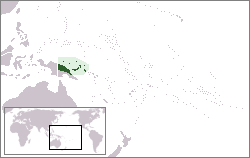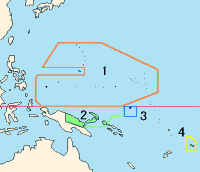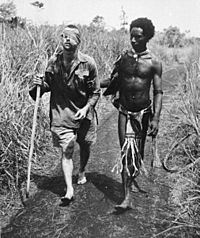Territory of New Guinea facts for kids
Quick facts for kids
Territory of New Guinea
|
|||||||||||
|---|---|---|---|---|---|---|---|---|---|---|---|
| 1914–1975 | |||||||||||
|
|
|||||||||||
 |
|||||||||||
| Status | League of Nations Mandate of Australia (1920–1946) United Nations Trust Territory of Australia (1946–1975) |
||||||||||
| Capital | Rabaul (1914–1937) Lae (1937–1942) Wau (1942) |
||||||||||
| Capital-in-exile | Port Moresby | ||||||||||
| Common languages | English (official) Austronesian languages Papuan languages English creoles German creoles |
||||||||||
| Government | Mandate, later Trust Territory of Australia | ||||||||||
| Monarch | |||||||||||
|
• 1914–1936
|
George V | ||||||||||
|
• 1952–1975
|
Elizabeth II | ||||||||||
| Administrator | |||||||||||
|
• 1914–1915
|
William Holmes (first) | ||||||||||
|
• 1934–1942
|
Walter McNicoll (last) | ||||||||||
| Legislature | Legislative council House of Assembly |
||||||||||
| Historical era | Interwar period | ||||||||||
| 28 June 1919 | |||||||||||
|
• Union with Papua
|
16 September 1975 | ||||||||||
| Currency | Australian pound | ||||||||||
|
|||||||||||
The Territory of New Guinea was a special area on the island of New Guinea. From 1914 to 1975, it was managed by Australia. First, it was a League of Nations Mandate, which meant Australia was asked to help govern it. Later, it became a United Nations Trust Territory.
In 1949, this territory joined with the Territory of Papua to form an administrative union. This union was called the Territory of Papua and New Guinea. In 1971, its name changed to Papua New Guinea. Even though they were joined, the Territory of New Guinea kept its own legal status. This lasted until it became part of the independent country of Independent State of Papua New Guinea in 1975.
Australia took control of this area from German New Guinea during World War I. Most of the Territory of New Guinea was taken over by Japan during World War II, from 1942 to 1945. After the war, the areas of Papua and New Guinea were joined together.
Contents
How New Guinea Became a Territory
In 1884, Germany officially took control of the northeast part of New Guinea. This area became known as German New Guinea. In the same year, Britain claimed the southeastern part, calling it British New Guinea. Britain fully took over this area on September 4, 1888.
Later, on March 18, 1902, British New Guinea was given to the new country of Australia. It was renamed the Territory of Papua. Australia began managing it in 1906.
World War I and Australia's Role

1. South Seas Mandate
2. Mandate of New Guinea
3. Mandate of Nauru
4. Western Samoa Mandate
When World War I started, Australia's armed forces quickly moved to capture German territories. In October 1914, the Australian Naval and Military Expeditionary Force seized German New Guinea and nearby islands. On September 11, 1914, Australian naval forces arrived at Rabaul. They landed troops to find German radio stations.
Rabaul was taken without a fight on September 12. The German government in the area surrendered on September 17. Australian troops then went on to occupy other German territories. These included the New Guinea mainland, New Ireland, and the Admiralty Islands. The colony stayed under Australian military control until 1921.
After the war, leaders met at the Paris Peace Conference in 1919. Australian Prime Minister Billy Hughes wanted Australia to keep New Guinea. He said these northern islands were vital for Australia's safety.
The Treaty of Versailles divided the lands of the defeated German Empire. In the Pacific, Japan received islands north of the equator. German Samoa went to New Zealand. German New Guinea, along with other islands, became a League of Nations Mandate for Australia. This meant Australia would help govern these areas. The League of Nations believed these people were not yet ready to govern themselves.
On December 17, 1920, the British Government, on behalf of Australia, accepted this role. Australia officially managed the Territory through the New Guinea Act 1920. This continued until Japan invaded in December 1941.
Life Between the Wars
The first civilian leader, Brigadier-General Evan Wisdom, made Rabaul the capital. German settlers in New Guinea were asked to leave starting in 1921. Only a few Germans were allowed to stay.
The economy of the former German colony had been growing. But it slowed down because of these changes. Many new plantation owners were former Australian soldiers. They often did not have much experience farming in tropical places.
In 1921, gold was discovered in Wau. A few years later, many gold seekers came to Wau. In 1926, an even richer gold field was found near Wau. There were no roads, so moving heavy equipment was very hard. Airplanes became important for transport. In 1937 and 1938, companies used large cargo planes to move more air freight between Lae and Wau than anywhere else in the world.
In 1937, two volcanoes near Rabaul erupted. This caused a lot of damage. The capital had to be moved to Lae. When Lae was destroyed by a Japanese air raid in 1942, the administration moved again to Wau.
New Guinea During World War II
Soon after the Pacific War began, Japan invaded New Guinea. Most of West Papua and large parts of the Territory of New Guinea were occupied. However, the Territory of Papua was mostly safe due to its location and mountains.
The New Guinea campaign started with battles for New Britain and New Ireland in 1942. Rabaul, the capital, was taken by Japan on January 22–23. It became a major Japanese base. From Rabaul, Japan tried to advance towards Port Moresby and Australia.
After a sea invasion failed, Japan tried to invade Port Moresby by land. This involved fighting along the Kokoda Track. From July 1942, young and untrained Australian soldiers fought bravely against the Japanese. They faced tough conditions in the Owen Stanley Ranges. Local Papuans, known as Fuzzy Wuzzy Angels, helped and guided injured Australian troops.
The Japanese were ordered to retreat from the Kokoda Track. This allowed them to focus on another battle. Australian and American forces then attacked Japanese bases in New Guinea. The fighting was very difficult due to tropical diseases, hard terrain, and strong Japanese defenses. The Allies finally won after many losses.
Fighting continued in New Guinea until Japan surrendered on September 2, 1945. The New Guinea campaign was a major part of the Pacific War. Around 200,000 Japanese soldiers died. About 7,000 Australian and 7,000 American service members also lost their lives.
Joining Forces: Papua and New Guinea
After World War II, the civilian governments of Papua and New Guinea were restarted. Under a new law, Papua and New Guinea were combined into one administrative union. This union was called the Territory of Papua and New Guinea.
However, the two territories still had different legal statuses for Australian citizenship. The new law created a Legislative Council in 1951. It also set up a court system, a public service, and local governments.
Under Australian Minister Andrew Peacock, the territory gained self-government in 1972. On September 15, 1975, the Territory became the independent nation of Papua New Guinea.




